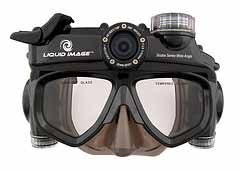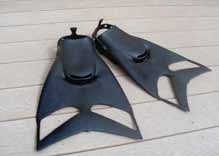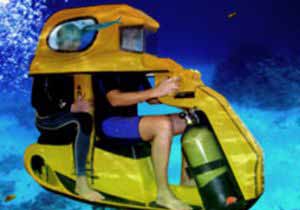The 2010 Dive Equipment ShowContents of this Issue: Gangga Resort, Manado, Indonesia Caribbean Explorer II: Saba/St.Kitts The San Francisco Ocean Film Festival Wants Your Video Divemasters in American Waters The Devil is Not in the Details Editorial Office: Ben Davison Publisher and Editor Undercurrent 3020 Bridgeway, Suite 102 Sausalito, CA 94965 something for (almost) every diver from the January, 2011 issue of Undercurrent
The Diving Equipment & Marketing Association’s November trade show was the usual mixed bag with products ranging from the sublime to the ridiculous. Registrants totaled 9700 – an 8% increase over last year. But the number of booths (1,178) and non-exhibitor attendees (3,925) were both down from 2009. So it seems the exhibitors sent more folks, while dive shops may have been a little less enthusiastic. Wandering the aisles in the Las Vegas Convention Center, I was struck by some new product trends, and a few oddball items that made me ask, “What were they thinking?” Catch Your Breath
Freediving booths and products popped up everywhere, perhaps in hopes of opening new markets for traditional dive shops. Since the freediving field is dominated by howdeep- can-I-go competitors or spearfishermen, this category has limited appeal to everyday scuba divers. Nevertheless, training schools such as Freediving Instructors International (www.freedivinginstructors.com) and Performance Freediving (www.performancefreediving.com) were prominent, as were specialty wetsuits from Australia’s Sharkskin Suits (www.sharkskin.com.au) and lots of other models in those oh-so distinctive camouflage-style designs, as if divers are deer hunters. Even SeacSub’s Shout full foot-long bladed fins come camo-colored (see www.seacsub.com/product.php?ID=857). For those who think that depth matters, the Xen freediving computer/bottom timer was unveiled by Liquivision (http://liquivision.com/xen_freedive.php). Safety First At last, more than lip service is being paid to diver safety, with 45 booths offering safety and rescue products or services, including a couple of snazzy GPS gizmos. SHB Instruments introduced the Navimate™ wrist-mounted GPS with an MSRP of $700. (www.shbinstruments.com/Navimate/info.html). Nautilus Lifeline (www.nautiluslifeline.com) booked more than 3,000 orders for its compact depth rated GPS, combined with a marine VHF radio ($299 retail). Why it’s taken so long to realize there’s big money in assuring divers can find their way home surprises me, but then add another $300 to what is already about the most expensive individual sport around, and we have part of the answer. The other part, of course, is that the technology is a 21st century thing. Even low-tech safety gear is getting spruced up. The Halon Corsair combines up to four primary and backup LED dive lights and choice of dive knife into one compact tool, complete with sheaf and retractable lanyard ($189.99 at http://divehalon.com/Products.html). How or why you could use four lights is up to your fertile imagination. The Innerspace dive watch (www.momentumwatch.com/pages/products/list-of-products/innerspace.php) manages to be low tech and high end at the same time. With a 300m/990ft depth rating, the watch features a bi-directional rotating bezel with orange numbers. The indexes and hands glow in the dark. Priced from around $795, it clearly qualifies as diver bling, just the kind of thing to outfit your personal posse. Three new computers sported jazzy full color interfaces. The Mares Icon HD (www.mares.com/product_detail.php?id=496®ion=deu) features a high definition LCD color display similar to those on cell phones. Plug it in and recharge wherever you are, unless you’re on a hang line . . . An air integration upgrade will be available next spring.
The Atomic Cobalt Air/Nitrox Integrated computer (www.atomicaquatics.com/computer.html) boasts an OLED (Organic Light Emitting Diode) color display and a 3D digital track back compass. It also includes a rechargeable lithium ion battery. For tech divers, Liquivision’s XEO Trimix Computer also sports a full-color OLED display, tap-interface, userreplaceable battery, strap or bungee mounting options and the Buhlmann-GF (ZHL16C) algorithm. Oceanic displayed prototypes of two highly anticipated product upgrades: the Atom 3.0 wrist computer and VT 4.0 puck-style model. They’re so new, as I wrote this they still weren’t on the Oceanic website: www.oceanicworldwide.com. Conversely, 26 booths touted rebreathers and related products or services (instruments, instruction, etc.). An impressive showing, despite an inbox full of recent bad publicity, and even calls for rebreathers to be banned (see Undercurrent, November 2010). Watch Your Hands, Buddy
Scuba divers were offered a number of hands-free devices, including Light & Motion’s Sola Dive lights with neoprene padded wrist mounts and adjustable straps. A “D” ring on the light offers alternative BCD or wrist clip options. Three models are listed at www.uwimaging.com/sola1200d.html from $379-$679, depending on light power. Liquid Image (www.liquidimageco.com) released the latest in scuba camera masks. The Scuba Series HD Wide Angle model shoots HD video and five megapixel stills. The new lens offers a 136-degree viewing angle, more than double the field of view of prior masks. The mask uses four AA batteries and expands with up to a 32GB SD memory card. Of course, these innovations raise the question of why divers need to weigh down their heads and keep their hands free in the first place. . . to grab coral? Pet fish? To Layer or Not to Layer Dry suit models abounded, with radically different approaches to insulation, supported by plenty of claims from the manufacturers. White’s Fusion Bullet and Ladies Fusion Tech suits have a Drycore loose fit shell incorporating latex seals, dry zipper, air intake and exhaust valves to create the waterproof barrier. An “over suit” made of durable stretch fabric is attached to the Drycore at the wrists, ankles and dry zipper to form a streamline fit. It’s available in three color combinations. MSRP is $2098 at http://whitesdiving.com/sport-diving/fusion-bullet-drysuit. BARE’s new SB System Trilam dry suit (www.baresports.com/en-US/Dive/Products/Drysuits/SB-system-drysuit) combines three lightweight layers that provide stretch for freedom of movement, and breathability to move moisture away from the skin and to exhaust trapped humidity, so they say. BARE guarantees seams and workmanship for the life of the suit. Even if you’re not the original owner, you’re covered. At the opposite end of the spectrum, go to www.waterproof-usa.com to check out the D1 Hybrid with a patented 3-D mesh inner lining designed to keep insulating air between the diver and the water. Waterproof claims that constant insulation at all depths evenly distributes water pressure and makes buoyancy control easier. The lining stays dry, and supposedly eliminates the need for heavy underwear. We shall see. The biggest gripes about dry suits -- leaky and flimsy seals, which seem to require attention on virtually every surface interval – were addressed by two manufacturers. Waterproof’s new Silicone Seal (www.waterproof.eu/index2.html) is said to have 40% better stretch than latex, to facilitate donning the suit and sealing with your skin. SI Tech’s Quick Cuff System (www.sitech.se/pages/default_uk.asp?SectionID=3569&ArticleID=7945) enables a quick exchange of seals, in case one gets ripped or the diver needs different size seals. Waterproof also introduced a line of wet suits. (Doesn’t the name “Waterproof” contradict the concept of a wet suit?) OK, so they are not waterproof, but with a choice of color accents, they’re très chic. Also on the fashion-forward front, Exceed Wetsuits (www.exceedwetsuits.com/index.php) introduced Electro Men’s 3/2mm full suits of E-stretch neoprene in black with orange insets. There’s even a contoured crotch for freedom of movement and comfort, thank you very much. The Eclectic women’s model in shocking pink is also contour cut . . . presumably for different contours, but in our travels we’ve seen more contours than the Alps, so if everyone gets a good fit, it’s magic. Get Your Kicks
If the new fins are any indicator, it looks like my old split fins are going the way of white bucks and saddle shoes. Take the APS Mantaray (www.apsmantaray.com) with a patented dual water channeling system claimed to add blade surface on the down stroke and reduce resistance on the up stroke, while improving blade stabilization. A scoop expands and contracts during kick cycles to create a pump action and channels focus the thrust off the blade tip at the same time. Mantaray claims the shorter blade design is reef-friendly and travels easily. My nomination for “Weirdest Fin Design since Force Fins” goes to Predator Power Fins (www.predatorpowerfins.com). With the tag line “Do you want to swim like a predator or like their prey?,” these babies feature aquatic wing shapes that supposedly mimic ocean-going predators’ tail fins. The current model, Power Elfins, retails for about $160. Make it Snappy Expensive, cutting-edge camera gear bristled from 48 different booths, but as a casual shooter I was struck by the Seashell “Universal” digital camera case. Two models fit more than 800 digital cameras. The stylish clear plastic cases come trimmed in a choice of colors, they’re waterproof to 40m/130 feet, and they retail for less than $218. They looked cool until I read the fine print on the website: http://seashell.hk. Turns out there’s no zoom lens control, and the camera flash causes internal reflections within the hard plastic body. Instead, manufacturer Zear Corp. of Hong Kong suggests using high shutter speeds (ISO800 or above) and external lighting. Getting Around
For surface support, Conquest Dive Kayak offered a line of inflatable kayaks with 40-gauge PVC viewing panels that allow paddlers to spy on underwater features and sea life. The hulls are constructed with four air bladders made from 20-gauge PVC, covered by a 1,200-denier marine polyester shell that resists punctures and tears. Nevertheless, a repair kit is included, so I wonder how well they would hold up as dive kayaks. Solo and tandem models can be seen at www.conquestkayaks.com. Oh, My Aching Dogs The last surprise at DEMA was the proliferation of foot and joint care products. Wheelchairs and scooters – the terrestrial kind -- were available to help attendees negotiate the cavernous Convention Center, and a number of booths offered pain relief products. A Neox Invasion Therapy Massage chair gave me a deep tissue rub while humming like the scary sound effects in “Jaws.” To make it through my second day on the floor, I picked up a pair of Happy Feet massaging insoles, to boot. They helped, but I still found myself dreaming about weightlessness. – Larry Clinton |

I want to get all the stories! Tell me how I can become an Undercurrent Online Member and get online access to all the articles of Undercurrent as well as thousands of first hand reports on dive operations world-wide
| Home | Online Members Area | My Account |
Login
|
Join
|
| Travel Index |
Dive Resort & Liveaboard Reviews
|
Featured Reports
|
Recent
Issues
|
Back Issues
|
|
Dive Gear
Index
|
Health/Safety Index
|
Environment & Misc.
Index
|
Seasonal Planner
|
Blogs
|
Free Articles
|
Book Picks
|
News
|
|
Special Offers
|
RSS
|
FAQ
|
About Us
|
Contact Us
|
Links
|
3020 Bridgeway, Ste 102, Sausalito, Ca 94965
All rights reserved.



 Into the world of self-propelled underwater vehicles
and submersibles, enter one of the show’s goofiest product
launches: Aqua Star’s sea scooters, which are ridden like
underwater bicycles. Two Models (the AS1 one-seater and
AS2 two-seater) were created to provide the underwater experience
to virtually anyone – no certification, no attached gear,
and no experience required. The user’s head goes into a
precarious-looking open-bottom helmet that’s integrated into the scooter body with the breathing apparatus mounted onboard the bike. Traveling at speeds of up to
4 mph, with a basic operating depth down to 40 feet, riders have access to shallow reefs without requiring
a weight belt or back strapped tank. Sounds like a cruise ship or family resort novelty. Check it out
at
Into the world of self-propelled underwater vehicles
and submersibles, enter one of the show’s goofiest product
launches: Aqua Star’s sea scooters, which are ridden like
underwater bicycles. Two Models (the AS1 one-seater and
AS2 two-seater) were created to provide the underwater experience
to virtually anyone – no certification, no attached gear,
and no experience required. The user’s head goes into a
precarious-looking open-bottom helmet that’s integrated into the scooter body with the breathing apparatus mounted onboard the bike. Traveling at speeds of up to
4 mph, with a basic operating depth down to 40 feet, riders have access to shallow reefs without requiring
a weight belt or back strapped tank. Sounds like a cruise ship or family resort novelty. Check it out
at 